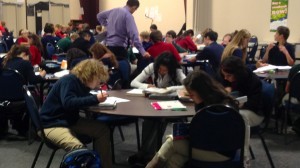(UPDATED, 5:24 p.m., with comments from state superintendent Sherri Ybarra.)
Idaho SAT scores dropped slightly in April — and the decrease was most pronounced in math.
On average, students scored a 1,353 on the test, according to results released Friday by the State Department of Education. That’s 10 points down from the 2014 average of 1,363 — and, again, well below the benchmark that denotes college readiness.
But a closer look at Friday’s news reveals that the decrease can be traced to one of the test’s three sections.
- Math scores averaged out at 449, a decrease from the 2014 average of 461.
- Critical reading scores dropped slightly. This year’s average was 461 average, down from the 2014 mean of 464.
- Writing scores increased, also slightly. The average came in at 443, up from 438 in 2014.
Friday’s SAT scores mark the second time in a month that Idaho has received troubling news about high school math achievement. In July, the state released scores on the Smarter Balanced Assessment Consortium tests, or SBAC, the first-year tests aligned to Idaho Core Standards in math and English language arts. The overall scores beat projections, but math scores declined in high school; only 30 percent of 10th-graders scoring proficient in math, compared to 61 percent of 10th-graders who were proficient in ELA.
About SAT Day, and college-readiness
The SAT is generally taken by college-bound high school juniors and seniors across the country. Idaho’s annual “SAT Day” is geared toward encouraging 11th-graders to take the test — and reflects two policies pushed by former state superintendent Tom Luna. Luna pushed to require all high school students to take a college-entrance exam, and also pushed for SAT Day, a one-day window during which the state pays student testing fees.
Consequently, a vast majority of Idaho juniors take the SAT. In a news release Friday, current state superintendent Sherri Ybarra did not mention this year’s SAT scores, but touted turnout; on April 15, 16,792 students across Idaho took the test.
But in a statement to Idaho Education News late Friday afternoon, Ybarra hinted she was concerned with the SAT Day approach. Now that the state pays fees for the SAT, lower-income students and limited English proficiency students are taking the test in greater numbers — and in turn, this diverse population sample could explain the state’s stagnant scores.
“These are the very reasons educators warned that we should shift from the old (No Child Left Behind) ‘one-size-fits-all’ culture, to the motion picture of growth, of our students, over time,” she said.

Most colleges require applicants to take a placement exam, as an indicator of college readiness.
In that regard, Idaho students still have considerable ground to cover.
The College Board, the nonprofit that administers the SAT, has defined 1,550 as a college-readiness yardstick: Students who hit this mark are more likely to enroll in a four-year college, more likely to succeed in their first year of college and more likely to stay in school and earn a degree.
Of the 196 schools listed in Friday’s report, only nine posted average scores of 1,550 or greater.
Top-ranked schools
The top 10 is comprised almost entirely of charter high schools — with only two public high schools on the list.
- Coeur d’Alene Charter Academy, Coeur d’Alene: 1,858 average, 60 test-takers.
- Renaissance High School, Meridian: 1,652 average, 158 test-takers.
- Sage International School, Boise: 1,618 average, 18 test-takers.
- Meridian Technical Charter High School, Meridian: 1,609 average, 43 test-takers.
- Xavier Charter School, Twin Falls: 1,594 average, 18 test-takers.
- Moscow Senior High School, Moscow: 1,586 average, 141 test-takers.
- Compass Public Charter School, Meridian: 1,569 average, 23 test-takers.
- Idaho Distance Education Academy, Post Falls: 1,564 average, 28 test-takers.
- Thomas Jefferson Charter School, Caldwell: 1,561 average, 23 test-takers.
- Liberty Charter School, Nampa: 1,548 average, 31 test-takers.
However, most of the high-ranking schools also benefit from a small sample size, with only a few dozen students taking the SAT. The largest high schools also have a much larger sample size, with 400 or more juniors taking the test.
